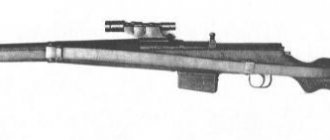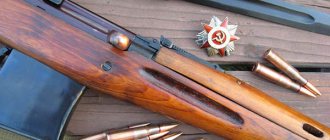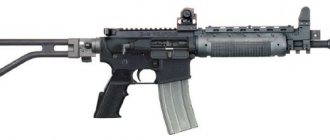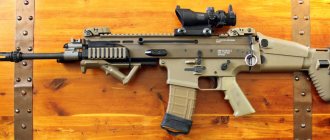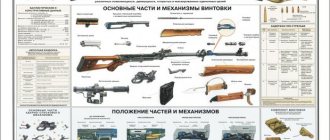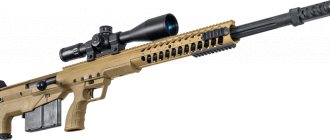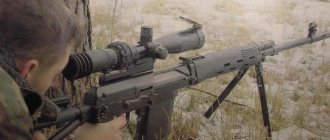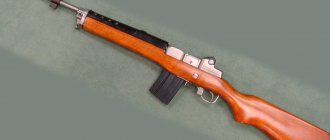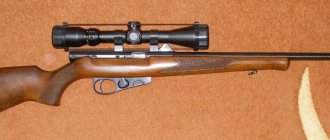The M1 Garand is a legendary American self-loading rifle from the Second World War, created by the talented Canadian weapons designer John Garand. It became the first self-loading rifle to be officially adopted as the infantryman's main weapon. The first self-loading rifle to enter service was the Soviet ABC-36, but it was never the main weapon of the Soviet infantry. Officially, the M1 Garand rifle was called US Rifle, Caliber.30, M1.
The M1 Garand rifle has gone through a glorious battle path; for Americans this weapon means no less than for us a PPSh assault rifle or a Mosin rifle. This weapon was first used in North Africa, then there was Sicily, the landing on the Normandy coast, the crossing of the Rhine and the Pacific theater of operations. The Americans actively used the M1 during the Korean War.
The M1 Garand rifle was only retired from US Army service in 1957, but it is still very popular among small arms enthusiasts.
History of the M1 Garand
The first attempts to create automatic weapons were made at the end of the 19th and beginning of the 20th centuries. True, nothing sensible came of it: the first samples were heavy, expensive to produce and not particularly reliable.
The issue of creating new types of automatic weapons became acute during the First World War. The experience of this conflict showed the critical importance of high fire density. Machine guns were perfect for defense; they created a real leaden barrage in front of the advancing infantry. But machine guns were not suitable for offensive operations. What was needed was a light and reliable rapid-fire weapon suitable for attack.
Weapon designers worked in two directions at once: in the creation of submachine guns that used pistol ammunition and in the development of self-loading rifles based on existing rifle ammunition.
It should be said that each of these types of automatic weapons had both its advantages and serious disadvantages. The success of a particular type of submachine gun or self-loading rifle depended more on the luck and talent of the designer who created it.
One of these designers was John Garand, who began work on creating a self-loading rifle during the First World War. At first, Garand developed weapons chambered for 7 mm caliber, but later the US military leadership refused to use this ammunition as the main one.
In general, the first prototype of the future self-loading rifle called TZ was ready by 1929. The automation in it worked by removing powder gases from the barrel; it was locked by turning the bolt, and the gas piston had a return spring.
However, the process of testing and fine-tuning the weapon was delayed. Only in 1936 the rifle received the M1 index and was adopted by the US Army. Almost immediately after the M1 Garand entered service with the troops, dozens of complaints began to pour in about the rifle. Their main reason was constant delays during shooting. On this occasion, a special commission was even created, which decided to urgently refine the weapon.
First of all, the gas exhaust system needed modernization. Already in 1939, Garand presented an improved version of the rifle, which was sent to the troops for testing and successfully passed it. In 1941, serial production of a new modernized version of the M1 began, and previously released samples had to be redone.
Currently, there are practically no modifications of the M1 Garand produced before 1941 in the world. They are of great value to gun collectors and cost over $20,000.
Despite the fact that at this time the US Army was already actively participating in hostilities, the supply of rifles to the troops was rather sluggish, and at the first stage of World War II, most of the American infantry used the outdated Springfield M1903.
In 1941, a new 7.62x33mm cartridge appeared and it was decided to create a carbine for it based on the M1 Garand rifle. John Garand was also directly involved in the development of new weapons. The soldiers immediately fell in love with the carbine. The soldiers gave him the affectionate nickname “baby garand.”
The new carbine was especially good in close combat; at short distances it surpassed even submachine guns in accuracy of fire. True, aimed fire from the “baby garand” could only be fired at distances of no more than 300 meters, but this was due to the shape of the bullet, and not to the design of the carbine.
The baby garand carbine had a replaceable magazine for 15 rounds, its weight was 2.6-2.8 kg. In 1944, a modification of the carbine appeared that could fire in bursts. This modification has a new magazine with a capacity of 30 rounds.
After creating an automatic carbine, Garand began creating a fully automatic modification of the M1 rifle. It also appeared in 1944, received the T20 index, 85% of its parts were unified with the M1 Garand. The new modification of the rifle received a replaceable magazine for 20 rounds.
In addition to the standard M1 Garand rifle, there were two more sniper modifications:
- the M1C rifle, which was released in 1944 and was equipped with an M81 telescopic sight;
- M1D rifle, which was equipped with an M82 scope.
There were also other modifications based on the M1 Garand in other countries.
The M1 Garand rifle saw service in the Korean War and was also used during combat in Vietnam. In the Vietnam conflict, this rifle was armed with the Viet Cong and Chinese volunteers.
A total of 5.5 million units of various modifications of the M1 rifle and 6.3 million units of the M1 carbine were produced.
Stories about weapons. M1 Garanda rifle
The M1 self-loading rifle was developed in the USA by designer John Garand in 1929.
The M1 went down in the history of small arms as the first self-loading rifle adopted as the main individual infantry weapon, and not in addition to existing repeating rifles. It is especially worth emphasizing the superiority of the Garand rifle. The world's first automatic rifle adopted by a specific army was the rifle of the Mexican Manuel Mondragon in 1907. The armies of many countries fought with this rifle; in total, more than 1.5 million units were produced.
The Garand rifle became the world's first automatic rifle adopted as the main infantry weapon, completely replacing the Springfield 30-06 rifle in the army.
In the world, the M1 became only the third after the mentioned Mondragon rifle and the Soviet ABC-36.
True, the number of M1s produced significantly exceeds the number of Mexican and Soviet rifles produced.
In total, the Springfield Arsenal produced about 4 million M1 rifles before 1945.
A lot of time passed from presentation to adoption in 1936. And fine-tuning the rifle took another 5 years, and mass production for the army began only in 1941. And in 1943, the US Army became the first army in the world to be fully equipped with automatic/self-loading weapons.
A rather long period of refinement did its job: the rifle was considered successful, moreover, its design contained components that are still signs of modern weapons today: a return spring in the gas piston tube, locking the barrel bore by turning the bolt.
The only criticism was the impossibility of reloading the rifle during the battle, since the design of the 8-round cartridge pack, which was thrown out of the magazine after the ammunition was completely used up, did not allow this.
Otherwise, the M1 has proven itself to be a reliable and effective weapon. First of all, this is confirmed by the absence of any serial modifications, except for the M1C and M1D sniper variants. But these were low-volume versions that were put into service in 1945.
Andrey Bondar from the Infanteria historical reconstruction club will talk about the design of the rifle.
During the war, attempts were made to equip the M1 with a shorter barrel with a conventional wooden or folding metal stock, but they did not go beyond the scope of experiments.
The rifle was equipped with a bayonet.
At the end of World War II, the production of M1 rifles in the United States was discontinued, and the rifles that were in warehouses were very quickly sold to other countries.
With the outbreak of the Korean War, production of M1 rifles was resumed. For this, in addition to Springfield Armory, the International Harvester Company was also involved.
Production of the M1 rifle continued from 1952 to 1957, when the M14 rifle was adopted in the United States. However, M1 rifles were in service until the 1960s and even survived the early period of the Vietnam War, and were later partly transferred to the US National Guard.
A small number of M1 rifles are still used by the US military as a ceremonial weapon.
Description of the M1 Garand rifle
The M1 Garand is a self-loading rifle, the automation of which is powered by the energy of powder gases removed from the barrel. It is locked by turning the bolt.
The gas piston and bolt carrier are a single unit; when turned, the bolt rests against two protrusions in the grooves of the receiver.
The trigger mechanism (trigger mechanism) is of a hammer type; it is made in the form of a separate module; when disassembling the weapon, it is completely removed and has a very simple and reliable design. It was so successful that subsequently the design of the M1 Garand rifle trigger was repeatedly copied when creating other types of weapons.
The rifle also had a very convenient safety lever in the form of a flag-lever, which was placed inside the trigger guard. A fighter could always determine by touch whether his rifle was on safety or not.
The rifle was fed using a pack that held eight rounds. It was inserted into the magazine through an open bolt and ejected through it after the ammunition was completely used up.
Thanks to the bolt delay, the frame remained in the rear position after the last ammunition was used, which significantly speeded up and facilitated the process of reloading the weapon. The fighter simply had to take out and insert the next pack of cartridges into the magazine.
This method of loading a rifle significantly increased its practical rate of fire, but also had some disadvantages. The ejection of an empty pack was accompanied by a characteristic sound, which could tell the enemy that the soldier had run out of ammunition. Often the Japanese took advantage of this and managed to run up and destroy the fighter.
However, experienced fighters learned to use even this disadvantage: they imitated the sound of an empty pack being thrown out of a magazine and calmly dealt with the enemy.
Loading a rifle using a pack also had one more weak point: the weapon could not be recharged. In addition, the requirements for the manufacturing quality of the pack itself were quite high.
Whether the clinking sound of an ejected pack was a serious drawback of the M1 Garand is still a matter of debate. This topic was once discussed at a meeting of American and German veterans, the latter called this shortcoming ridiculous, saying that it was simply impossible to hear such noise during a battle.
Sights consisted of a front sight, closed on both sides, and a diopter rear sight.
On sniper modifications, a mount for an optical sight was installed, which was shifted away from the axis of the weapon so as not to interfere with the extraction of cartridges and empty packs.
The stock of the M1 Garand rifle was made of wood, the fore-end and the upper pad came separately.
The M1 was equipped with a bayonet and a muzzle, which was used to shoot rifle grenades.
Description
The M1 Garand is a self-loading rifle, the automation of which is powered by the energy of powder gases removed from the barrel. It is locked by turning the bolt.
The gas piston and bolt frame are a single unit; when turned, the bolt rests with 2 protrusions against the grooves of the receiver.
The trigger mechanism (trigger mechanism) is of a hammer type; it is made in the form of a separate module; when disassembling the gun, it can be completely removed and has a very simple and reliable design. It was so successful that the design of the trigger mechanism for the M1 Garand rifle was later copied more than once during the development of other types of guns.
The rifle also had a very successful safety lever in the form of a flag-lever, which was located inside the trigger guard. A fighter could always find out by touch whether his rifle was on safety or not.
The rifle was fed using a pack that held eight rounds. It was inserted into the magazine through an open bolt and ejected through it after the ammunition was completely used up.
Thanks to the bolt delay, the frame remained in the rear position after the last ammunition was fired, which significantly speeded up and facilitated the process of reloading the gun. The fighter simply had to take out and insert the next pack of cartridges into the magazine.
This method of loading a rifle significantly increased its practical rate of fire, but also had some drawbacks. The release of an empty pack was accompanied by a corresponding sound, which could give a hint to the enemy that the fighter had run out of ammunition. Often the inhabitants of the Land of the Rising Sun took advantage of this and managed to run up and kill the fighter.
But experienced fighters learned to use even this flaw: they imitated the sound of an empty pack being thrown out of the store and quietly dealt with the enemy.
Loading a rifle using a pack also had another weak point: the gun could not be loaded. In addition, the requirements for the quality of production of the pack itself were quite high.
The question of whether the ejection noise was a serious defect of the M1 Garand is still a matter of debate. This topic was once discussed at a meeting of American and German veterans, the latter called this defect ridiculous, saying that it was simply unrealistic to hear such noise during a battle.
Sights consisted of a front sight, closed on both sides, and a diopter rear sight.
On sniper modifications, a mount for an optical sight was installed, which was shifted away from the axis of the gun so as not to interfere with the extraction of cartridges and empty packs.
The stock of the M1 Garand rifle was made of wood, the fore-end and the upper pad were separate.
The M1 was equipped with a bayonet and a muzzle, which was used to shoot rifle grenades.
Pros and cons of the M1 Garand
The M1 Garand self-loading rifle is an excellent example of small arms, the main advantages of which were simplicity, reliability, excellent rate of fire and good accuracy of fire. Considering the fact that the M1 Garand was one of the first self-loading rifles, it can be considered an outstanding example of small arms, and its creator a talented weapons designer.
The advantages of the M1 over a conventional rifle were obvious. In one minute, the average shooter could fire almost twice as many shots as with a conventional repeating rifle.
The M1 also had disadvantages, almost all of them related to the ammunition that this rifle used. The cartridge had excessive power, which significantly heavier the design, making it unnecessarily complex and expensive.
All these problems were solved only after the advent of automatic weapons created for intermediate ammunition. But that's a completely different story.
Range Report: M1 and M2 Carbine
We'll tell you how Soviet testers rated the American carbine, and why it received mixed reviews from other troops around the world
Some said that “this fart” cannot even penetrate the quilted jacket of a Chinese communist at point-blank range and is generally terribly unreliable. Others noted the ease and convenience of handling. And the truth, as always, was somewhere nearby...
In preparation for their country's entry into World War II, the Americans, remembering past negative experiences, tried to at least roughly estimate the “bottlenecks” of their relatively small army. In particular, they drew attention to the large number of “service personnel” - drivers, signalmen, and so on. On the one hand, for these categories of military personnel, the Thompson or Garand was frankly heavy and interfered with work. On the other hand, they still had to be close to the front line, and all sorts of cases happen.
Thompson submachine gun
As a result, the Department of Armaments launched a “light rifle” project, within which it was necessary to create a weapon that was effective for short ranges and weighed half the weight of a garand.
In the end, the model created by a group of designers led by Edwin Pugsley turned out to be the most successful. At the same time, the design used a short-stroke gas piston design developed by David Williams. Previously, during the so-called During Prohibition, Williams was the owner of a small moonshine distillery, but eventually went to prison for the murder of a sheriff's deputy, where he became interested in designing weapons. Williams himself also worked for Winchester, but his project was late and did not take part in the competition.
The main highlight was the new cartridge, specially developed for this project - 7.62 × 33 mm, also known as .30 Carbine.
It is interesting that even then the USSR was monitoring the progress of the overseas project. Fortunately, for this it was not necessary to introduce Stirlitz and Sorge into the American Department of Armaments, but it was enough to just open the magazine “Army Ordnance”. By 1942, Soviet designers had also created several prototypes of weapons similar in purpose - for example, the Maina system carbine - and some of them had already been tested. However, during the war, the USSR simply did not have much opportunity to launch additional production of new cartridges. Therefore, during testing, carbines created for the domestic 7.62x25 pistol cartridge did not show any particular advantages over the PPSh and PPD submachine guns.
However, the American M1 Carbine was ordered under Lend-Lease and carefully studied. At the same time, it was compared not only with domestic models, but also with the already captured MkB 42 automatic carbine. It was noted that the American cartridge occupies an intermediate position between the German 7.92x33 mm “kurz cartridge” and our pistol cartridge, both in terms of ballistics and energy closer to the TT cartridge. The interest of the testers was aroused by the high density of gunpowder loading in the American cartridge, which was recommended for ammunition specialists, in particular, developers of PTR cartridges, to pay attention to.
However, the carbine itself aroused no less interest:
When shooting for accuracy at distances of 100 and 300 meters, the “American” surpassed in accuracy both the “German” and the domestic Degtyarev carbine chambered for a pistol cartridge (one of those mentioned above). The serious advantage of the “kurzpatron” appeared only when shooting at 500 meters.
When shooting in various conditions (thick lubrication, dry parts, shooting at high angles), the automatic system worked normally, giving only one delay per 100 shots with thick lubrication. True, shooting with freezing or dust, which is “traditional” for the range, was not carried out this time.
Overall, our testers liked the carbine. The final conclusions stated: “The 7.62 mm American self-loading carbine “M1”, designed for a special cartridge, approximately ½ times more powerful in terms of muzzle energy than the domestic pistol cartridge, deserves very serious attention.”
It was also noted that by changing the shape of the bullet to a rifle type, the ballistic data could become noticeably better.
In general, by the end of World War II there was a rather positive opinion about the M1 carbine. But the next Korean War changed everything radically. The troops began to receive massive complaints about the reliability of the automatic version of the carbine, the M2. It has been called the most unreliable weapon in the US military. In the summer, the slightest contamination or water ingress caused problems. In winter, the M2 did not fire the first 20 shots in automatic mode. Ammunition in stores constantly rusted and required regular inspection.
The attitude of American soldiers towards the M2 is perfectly characterized, for example, by the episode that occurred with a company of the 27th Infantry Regiment on the night of November 26-27, 1950. Having repulsed several enemy attacks, the Americans decided to retreat from the position, taking the wounded, the bodies of the dead and all the weapons... except for the carbines. “They were scattered around the hill, but no one wanted to pick them up. During the battle, we discovered that these things were not very good and decided that they would not help the enemy.”
There were also a large number of complaints about the low lethality of the bullet, especially from the Marine Corps.
“About 30% of our carbines gave us trouble; some did not fire at all, others intermittently. But the main reason my men lost confidence in the carbine was because they saw Chink not stopping when hit in the chest at 25 yards. This happened to me too; the man simply winced and continued walking.”
However, this negative experience did not put an end to M1’s “career”. It continued to be actively used and fought all over the world - for example, in Cuba, the carbine was Che Guevara’s favorite weapon.
The US supplied the South Vietnamese army with more than 700 thousand “carbines” - more than M16 rifles. Currently, the M1 is armed, for example, by some units of the Philippine army and police, since this weapon is considered very successful for operations in the jungle.
Pros and cons
The M1 Garand self-loading rifle is a beautiful prototype of a small gun, the main advantages of which were simplicity, reliability, good rate of fire and good accuracy of fire. Considering the fact that the M1 Garand was one of the first self-loading rifles, it can be considered an outstanding prototype of a small gun, and its creator is a professional weapons designer.
The advantages of the M1 over an ordinary rifle were obvious. In one minute, the average shooter could fire almost twice as many shots as from an ordinary repeating rifle.
The M1 also had its shortcomings; in fact, they were all related to the ammunition that this rifle used. The cartridge had excessive power, which significantly burdened the design, making it unnecessarily complex and expensive.
All these problems were solved only after the emergence of an automatic weapon made for intermediate ammunition. But that's a completely different story.
